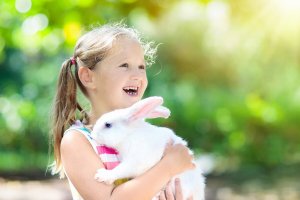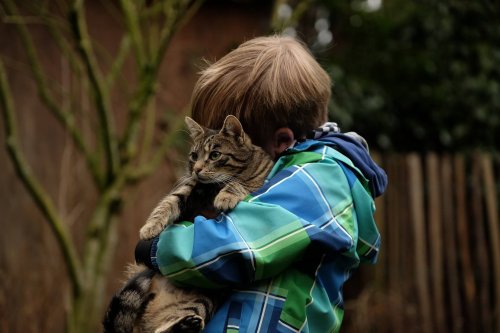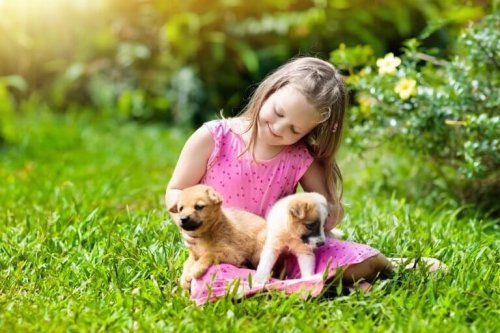The Friendship Between Pets and Children

Pets are part of the lives of many children. In fact, children who learn to care for animals and treat them with kindness and patience can receive invaluable education that teaches them to treat people the same way. Among other things, this shows that the friendship between pets and children is very positive.
While all types of pets can bring joy to children, it’s important to choose an animal that is suitable for your family’s home and lifestyle. Incorporating a pet into the family isn’t a decision that should be taken lightly.
Firstly, the parents are the ones who have to commit, not the children, since they’ll be ultimately responsible for the pet’s well-being. Once you find the ideal animal for your family, the joys and benefits of the relationship will be long-lasting.
Although pets have been identified as a direct source of company and support for their owners, their roles as a catalyst for the formation of friendships or social support networks among humans have received special attention.
A study was carried out to determine the indirect role of pets as facilitators of three aspects of social relationships: meeting people, forming friendships, and social support networks.
Benefits of friendship between pets and children
Up next, we’ll list the advantages of having a pet at home for children:
1. Promotes confidence and self-esteem
Children can gain confidence by taking responsibility for the care of a pet. Children up to 3 years of age can begin to perform simple tasks, such as filling the animal’s water and food bowls. As they grow up, they can take control of other tasks.

2. Pets give unconditional love
This is especially true for lonely children or when there’s a rivalry between siblings. A pet gives them someone to talk to and have a good time with. An animal can give comfort, provide support, and listen to a child’s problems without any judgment or consequence.
Additionally, a pet can become a child’s best companion while playing. More often than not, a friendship between pets and children is as healing as the relationships with their peers.
3. Child development, social progression, and responsibility
Pets are good for infantile, social, and emotional development. They also help teach children about responsibilities.
By giving children the responsibility of taking care of a pet, we help them learn how to deal with obligations and prepare them for the future.
In fact, it’s very important that you talk to your children about the responsibilities of having a pet before getting one. They must be clear about their tasks and not rely on the parents to do all the work.
“Animals are such agreeable friends; they ask no questions, they pass no criticisms.”
–George Eliot–
4. Pets encourage physical activity
When children interact with their pets, it means they aren’t glued to the television or the computer screen. Moreover, an additional advantage of having pets is that it allows children to spend more time out of the house.
Whether it’s for walking the dog or taking the rabbit to chew fresh vegetables, pets encourage children to spend time in natural environments and to exercise a bit. Any type of physical activity is good for a child’s learning process and health in general.
In fact, research has shown that children who have dogs exercise an average of 11 minutes more per day than other children who don’t.

5. A good option for children with autism
Lastly, you should know that studies demonstrate that children with autism have made substantial progress in relation to social interactions when they spend time with a pet.
Along these lines, researchers at the University of Queensland in Australia validate that when autistic children play with animals, they show a significant increase in their ability to speak, smile, look at faces, make contact, and achieve social activities.
Furthermore, pets can also help all children develop appropriate social skills. These skills can later transform into human interaction.
In conclusion, remember that the friendship between pets and children is a loving relationship. As you’ve seen, it has numerous benefits. If you still don’t have one, it may be important to consider it and propose it to your child.
Pets are part of the lives of many children. In fact, children who learn to care for animals and treat them with kindness and patience can receive invaluable education that teaches them to treat people the same way. Among other things, this shows that the friendship between pets and children is very positive.
While all types of pets can bring joy to children, it’s important to choose an animal that is suitable for your family’s home and lifestyle. Incorporating a pet into the family isn’t a decision that should be taken lightly.
Firstly, the parents are the ones who have to commit, not the children, since they’ll be ultimately responsible for the pet’s well-being. Once you find the ideal animal for your family, the joys and benefits of the relationship will be long-lasting.
Although pets have been identified as a direct source of company and support for their owners, their roles as a catalyst for the formation of friendships or social support networks among humans have received special attention.
A study was carried out to determine the indirect role of pets as facilitators of three aspects of social relationships: meeting people, forming friendships, and social support networks.
Benefits of friendship between pets and children
Up next, we’ll list the advantages of having a pet at home for children:
1. Promotes confidence and self-esteem
Children can gain confidence by taking responsibility for the care of a pet. Children up to 3 years of age can begin to perform simple tasks, such as filling the animal’s water and food bowls. As they grow up, they can take control of other tasks.

2. Pets give unconditional love
This is especially true for lonely children or when there’s a rivalry between siblings. A pet gives them someone to talk to and have a good time with. An animal can give comfort, provide support, and listen to a child’s problems without any judgment or consequence.
Additionally, a pet can become a child’s best companion while playing. More often than not, a friendship between pets and children is as healing as the relationships with their peers.
3. Child development, social progression, and responsibility
Pets are good for infantile, social, and emotional development. They also help teach children about responsibilities.
By giving children the responsibility of taking care of a pet, we help them learn how to deal with obligations and prepare them for the future.
In fact, it’s very important that you talk to your children about the responsibilities of having a pet before getting one. They must be clear about their tasks and not rely on the parents to do all the work.
“Animals are such agreeable friends; they ask no questions, they pass no criticisms.”
–George Eliot–
4. Pets encourage physical activity
When children interact with their pets, it means they aren’t glued to the television or the computer screen. Moreover, an additional advantage of having pets is that it allows children to spend more time out of the house.
Whether it’s for walking the dog or taking the rabbit to chew fresh vegetables, pets encourage children to spend time in natural environments and to exercise a bit. Any type of physical activity is good for a child’s learning process and health in general.
In fact, research has shown that children who have dogs exercise an average of 11 minutes more per day than other children who don’t.

5. A good option for children with autism
Lastly, you should know that studies demonstrate that children with autism have made substantial progress in relation to social interactions when they spend time with a pet.
Along these lines, researchers at the University of Queensland in Australia validate that when autistic children play with animals, they show a significant increase in their ability to speak, smile, look at faces, make contact, and achieve social activities.
Furthermore, pets can also help all children develop appropriate social skills. These skills can later transform into human interaction.
In conclusion, remember that the friendship between pets and children is a loving relationship. As you’ve seen, it has numerous benefits. If you still don’t have one, it may be important to consider it and propose it to your child.
All cited sources were thoroughly reviewed by our team to ensure their quality, reliability, currency, and validity. The bibliography of this article was considered reliable and of academic or scientific accuracy.
- Gómez G., L. F., Atehortua H., C. G., & Orozco Padilla, S. C. (2007). La influencia de las mascotas en la vida humana. Revista Colombiana de Ciencias Pecuarias, ISSN-e 0120-0690, Vol. 20, No. 3, 2007, Págs. 377-386.
- González Jiménez, A., Márquez Hernández, V., López Rodríguez M. (2015). Educación y salud en una sociedad globalizada. Edition: 1ª, Chapter: 39. Universidad de Almería. Pp.186-192. Extraído de: https://books.google.es/books?hl=es&lr=&id=VjwwBwAAQBAJ&oi=fnd&pg=PA186&dq=amistad+mascotas+y+niños&ots=gZSP8yTJVE&sig=wQCtniVtSde2BjvJE-1BaibDLEA#v=onepage&q=amistad%20mascotas%20y%20niños&f=false
- Owen, C. G., Nightingale, C. M., Rudnicka, A. R., Ekelund, U., McMinn, A. M., van Sluijs, E. M., … & Whincup, P. H. (2010). Family dog ownership and levels of physical activity in childhood: findings from the Child Heart and Health Study in England. American journal of public health, 100(9), 1669-1671. Extraído de: https://ajph.aphapublications.org/doi/full/10.2105/AJPH.2009.188193
- O’Haire, M. E., McKenzie, S. J., Beck, A. M., & Slaughter, V. (2013). Social behaviors increase in children with autism in the presence of animals compared to toys. PloS one, 8(2), e57010. Extraído de: http://journals.plos.org/plosone/article?id=10.1371/journal.pone.0057010
- Taxa, J. (2012). Representaciones y vínculo entre niños y sus mascotas (MasterThesis). Pontificia Universidad Católica de Perú. Lima. Extraído de: http://tesis.pucp.edu.pe/repositorio/bitstream/handle/123456789/1701/TAXA_MARCOS_JUAN_CARLOS_REPRESENTACIONES.pdf?sequence=1&isAllowed=y
- Wood, L., Martin, K., Christian, H., Nathan, A., Lauritsen, C., Houghton, S., … & McCune, S. (2015). The pet factor-companion animals as a conduit for getting to know people, friendship formation and social support. PloS one, 10(4), e0122085. Extraído de: https://journals.plos.org/plosone/article?id=10.1371/journal.pone.0122085
This text is provided for informational purposes only and does not replace consultation with a professional. If in doubt, consult your specialist.








